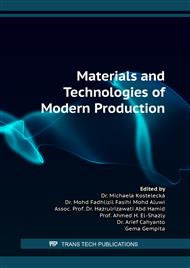p.103
p.111
p.119
p.131
p.139
p.147
p.157
p.163
p.173
PVDF/UIO-66 Hybrid Membrane for Cation Separation in Electrodialysis System
Abstract:
Membranes are used in various different applications in water treatment due to the wide array of properties that can be attained from different materials and polymers. A new hybrid membrane for the purification of water by electrodialysis has been manufactured and studied in this research. The membrane consists of two different materials: A host polymer matrix and a cation selective metal organic framework, MOF. For the polymer matrix, polyvinylidene fluoride, PVDF, was selected to act as the body that is meant to be the backbone of the membrane. It was dissolved in different solvents with different concentrations to determine the most stable matrix. Using scanning electraon microscope, SEM, imaging, it was found that 10% wt in dimethylformamide (DMF) provided the most suitable conditions for this work. As for the cation selective MOF, UIO-66 was selected and then synthesized using hydrothermal method and characterized using X-ray diffraction, XRD, and found to match previous literature. UIO-66 provides the membrane with cation selectivity, which allows the membrane to function in an electrodialysis system, so it was dissolved with the PVDF matrix to provide a hybrid membrane. Different amounts of the MOF in the membrane matrix were tested to find the most suitable distribution of the MOF over the surface of the membrane and was found to be around 2%. The membrane was tested with LiCl salt, before and after UIO-66 addition, in a half cell to measure the influence of the UIO-66 as a cation selective material and its effect on ion migration.
Info:
Periodical:
Pages:
139-144
Citation:
Online since:
September 2022
Authors:
Keywords:
Price:
Сopyright:
© 2022 Trans Tech Publications Ltd. All Rights Reserved
Share:
Citation:



